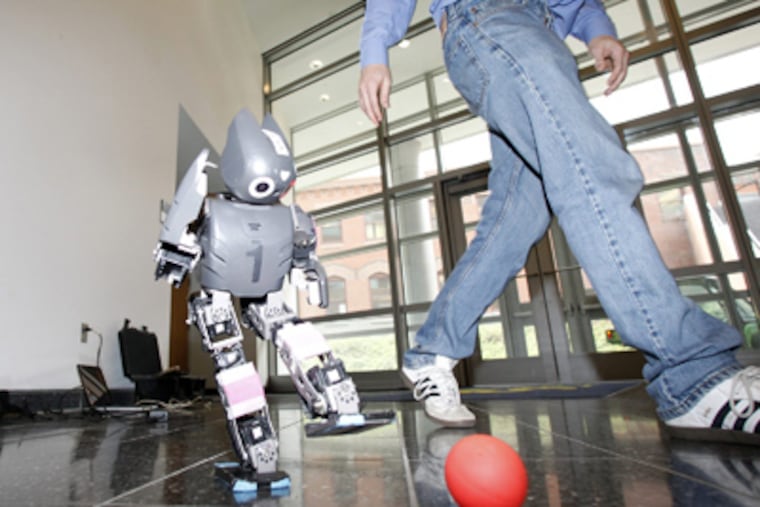Tech Life: Shooting hoops at the ‘bot expo
Human-shaped robots, reminiscent of Star Wars’ C-3PO, may have been the celebrities at this week’s Philly Robotics Expo at Drexel University. The Korean-made Hubo, a 4-foot-3-inch bot that can dance and play musical instruments, made a cameo.

Human-shaped robots, reminiscent of Star Wars' C-3PO, may have been the celebrities at this week's Philly Robotics Expo at Drexel University. The Korean-made Hubo, a 4-foot-3-inch bot that can dance and play musical instruments, made a cameo. So did the Darwin-OP, Hubo's smaller cousin, which showed off the soccer skills crucial to competing in international RoboCup tournaments.
But the real stars were the kids behind robots that were comparatively shapeless and lower-tech — students from places such as Philadelphia's Central, Girls, and George Washington High Schools, Hatboro-Horsham, and Pottstown, who came to Drexel on Monday to show what their homemade robots could do.
Robotics teams haven't quite replaced football or basketball at schools in the area. But the technology and the social forces driving the discipline — including a growing national emphasis on "STEM education" to promote the study of science, technology, engineering, and mathematics — are plainly leaving their mark.
"It's still probably nerdy," Sam Perry, a junior at Hatboro-Horsham High School, told me when I asked how robotics fits into his high school's culture. "But nerdy is the new cool."
Eric Zygmont, coach of the Hatboro-Horsham robotics team, said the basketball-shooting robot being demonstrated Monday cost about $4,000 to build. Only a fraction went to buy a National Instruments CompactRIO, an industrial automation controller that serves as the brick-shaped brains of the shooter, nicknamed RumbleBee by the 25-member team, Hardwired Fusion.
The rest pays for the parts — components such as sensors, speed controllers, motors, bearings, wheels, and aluminum framing — that distinguish the body of a robot from its brains. A robot, above all, has to sense its environment, respond to it, and manipulate it.
It's a classic case of "easier said than done," as the University of Pennsylvania's Daniel D. Lee demonstrated during the expo's keynote, when he showed the audience a Darwin-OP kicking a mini-soccer ball — then falling and standing itself right back up with what undoubtedly counts as robotic grace, circa 2012.
Lee, an associate professor of electrical and systems engineering and also of bioengineering, studies questions such as how artificial sensory systems can learn from experience and adapt, as humans do so effortlessly. His work takes him into the complexities of topics such as computational neuroscience and machine-learning algorithms, and in the long run may contribute to one of the holy grails of robotics: making machines that can substitute for humans at complex everyday tasks. One reason that Korea and Japan have emphasized robotics is the hope that robots can eventually help cope with the needs of their aging populations.
The goals of the high schoolers at the Philly Robotics Expo, not to mention their time horizons, are more modest, according to Zygmont and Daniel Ueda, his counterpart at Central High, a physics teacher and coach of Central's RoboLancers. Central's 35-member team, led by president Meghan Ho, organized Monday's show.
"I don't have some passion for robots — I'm not particularly fond of robots," said Ueda, who said students often arrive knowing almost nothing about programming, mechanics, or electronics. "It's more a passion for getting them to understand what they're capable of. It's truly amazing sometimes."
The robotics teams often compete in several challenges. In addition to shooting basketballs, this year's goals included designing robots that can pick up balls, dump them into crates, and raise the crates off the ground. To make their basketball robot move semi-autonomously, one of the challenge's options, the Central team rigged it to a Microsoft Kinect controller. An operator's body motions make the robot move. Similar kinds of robots, as well as those that operate autonomously, have already moved into the mainstream. Some work in manufacturing or assist in surgeries. Others, better known as drones, have stirred controversy as they help the military fight in Afghanistan.
The students designing robots to shoot basketballs aren't engaged in cutting-edge research. But the hope is that they someday may be, or will help fill other crucial jobs in our tech-centered economy. Like about 80 percent of his team at Hatboro-Horsham, Perry plans to enter one of the STEM fields — in his case, mechanical or electrical engineering, he said.
Meanwhile, they're intent on building things like the best possible free-throw shooter — a robot that picks up balls, identifies the basket, aims, and shoots.
"We have about 85 percent success," Zygmont said. "We're more accurate than the 76ers."
Contact Jeff Gelles at 215-854-2776 or jgelles@phillynews.com.